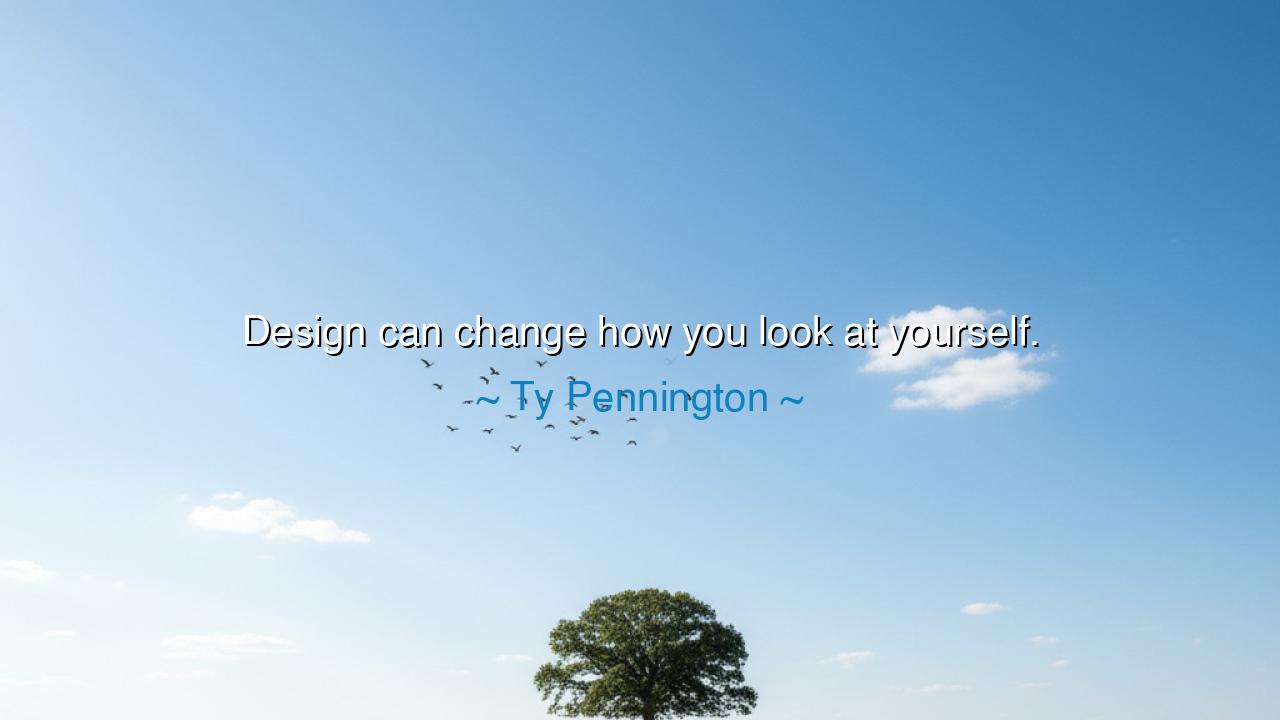
Design can change how you look at yourself.






In the luminous words of Ty Pennington, designer, builder, and visionary of transformation, there lies a truth that reaches beyond the surface of walls and furniture: “Design can change how you look at yourself.” Though born from the realm of architecture and home renewal, this saying carries the spirit of philosophy. For what is design but the art of shaping our surroundings — and what are surroundings but mirrors of the soul? When Pennington speaks, he does not merely speak of color or space; he speaks of identity, of how the outer world we build can awaken something sleeping within us. He reminds us that design, rightly understood, is not decoration — it is revelation.
To change how you look at yourself is one of the most sacred transformations in life. Many people live amid clutter, not just of possessions, but of self — trapped in environments that echo their chaos, fear, or neglect. Yet, when design enters — when space is shaped with care, order, and meaning — it does something miraculous: it begins to heal the spirit. Pennington, through his work transforming homes for families in need, witnessed this truth again and again. When a person steps into a space that reflects dignity, beauty, and light, something shifts deep within — they begin to see themselves as worthy of the beauty that surrounds them. The home becomes a teacher, whispering, You are not what you have suffered. You are capable of harmony, of balance, of renewal.
The origin of Pennington’s insight comes from his years of creating homes not just for comfort, but for redemption. On shows like Extreme Makeover: Home ion, he saw that design could do what words often could not — restore faith. For those who had endured hardship, neglect, or disaster, a renewed home was more than shelter; it was a symbol of rebirth. A room filled with light could remind a grieving parent that there was still hope. A space designed with intention could tell a child, You matter. In these acts, Pennington became not merely a designer of structures, but a designer of souls rediscovered. Through his work, he revealed that when we reimagine the world around us, we also reimagine ourselves within it.
This truth is not new. The ancients, too, knew the sacred power of design. The architects of Greece and Egypt, the builders of temples and cathedrals, understood that form shapes feeling. The Greeks raised marble columns toward the heavens not only for gods but for man — to remind him that he, too, could stand upright, noble, and enduring. The Gothic cathedrals of Europe, with their soaring arches and stained glass, were designed to lift the gaze upward, to awaken awe and humility in the human heart. They did not simply decorate space; they transformed the soul. In their sacred geometry lay a lesson as old as time: the spaces we build build us in return.
To live in a well-designed space, then, is to live in harmony with one’s own potential. Design is not luxury — it is language. A space that breathes order and light teaches us discipline and peace. A space filled with beauty teaches us gratitude and vision. Even the smallest change — the clearing of clutter, the introduction of color, the placement of a cherished object — can shift the rhythm of the mind. When we shape our environment with intention, we engage in a sacred dialogue with the self. Every brushstroke, every pattern, every chosen texture says, This is who I am. This is what I value. This is how I wish to live.
Yet the power of design extends beyond the physical. To design your surroundings is also to design your life — to build habits, relationships, and goals that reflect the truth of who you are becoming. The one who tends to their space learns to tend to their soul. The one who curates beauty learns to see beauty in themselves. Thus, Pennington’s wisdom reminds us that transformation begins not in grand gestures but in small acts of creation. When you make the world around you orderly, uplifting, and alive, you begin to awaken the same qualities within. Design, in this sense, becomes a mirror — and the reflection it shows can inspire a new way of being.
Let this be the lesson for all who hear: Design with purpose, and you will live with purpose. Do not neglect the space in which you dwell, for it is the soil in which your spirit grows. Clear what no longer serves you; surround yourself with what uplifts. Create beauty not to impress, but to express — to remind yourself daily of the life you are capable of living. For when you shape your world with love and intention, you are not just building walls and rooms — you are building the self that dwells within them.
And so, my children, remember the timeless wisdom of Ty Pennington: that design can change how you look at yourself. It is not vanity, but vision; not luxury, but love. To design is to declare, I am worth the light that fills my home and the order that fills my life. Shape your space as you would shape your destiny — with courage, with care, with creativity. For the home, like the soul, is a work of art — and every brushstroke you make upon it becomes a reflection of the beauty you are becoming.






AAdministratorAdministrator
Welcome, honored guests. Please leave a comment, we will respond soon